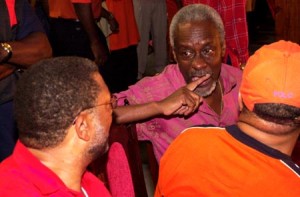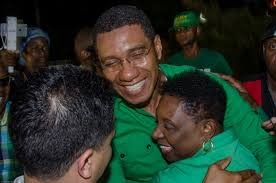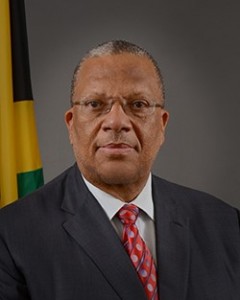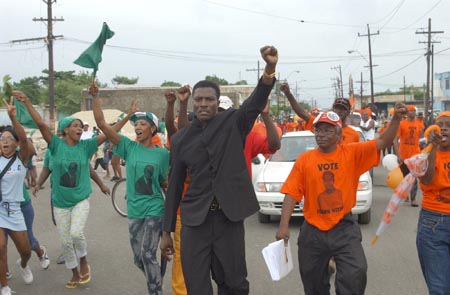Thirty percent of PNP supporters in the 2016 general election failed to support the party in the latest general election held yesterday and was the main factor behind the massive landslide loss the party suffered in the 202 contest.
 The preliminary results showed that 37 percent of the electorate voted, down from around 50 percent in 2016, when the voters’ list was purged of deceased persons. That is a colossal decline. Although the Jamaica Labour Party scored a convincing victory over the Peoples National Party, winning 49 of the 63 seats, both parties recorded reduced support.
The preliminary results showed that 37 percent of the electorate voted, down from around 50 percent in 2016, when the voters’ list was purged of deceased persons. That is a colossal decline. Although the Jamaica Labour Party scored a convincing victory over the Peoples National Party, winning 49 of the 63 seats, both parties recorded reduced support.
The JLP won 406,764 of the popular votes, down by 7.4 percent from 2016. The PNP support nosedived by a whopping 30 percent or 128,500 votes compared to the 2016 elections to 305,157. The declines occurred despite 89,000 voters were added to the list since 2016. The question on the voters the overall assessment of the management of the country shows 22 percent of those who said they voted for the party in the last election said the government was doing a very good job while 45 percent said they were doing a good job. The numbers suggest division within the ranks of the PNP also played a role in the level of the defeat.
The 2016 election, the JLP polled 436,972 votes and the PNP 433,735, a total of 882,389 votes, but in the 2020 election saw only 712,000 votes cast a stunning fall. The spreading of the COVID virus seems to have had a significant effect of voters, with Public opinion polls conducted a week from the elections, indicating a fall in the decision to vote based on the spread.
30% fall in PNP’s support
10 seats to win for PNP
Public opinion polls are all out and forecasting a massive victory for the JLP over the PNP, when the votes are tallied on September 3. The polls suggest a range of possible voter support, from 60 percent for the JLP and 40 for the PNP to a high of 68 percent for the JLP and a low of 32 percent for the PNP.
 When applied against the 2016 results, the data suggests that the PNP can only rely on getting around 10 seats, with a few others ending up in the marginal column. Even some that appear safe could fall with the massive swing the polls suggest. The swing to the JLP started from around 2014 and started to gather- momentum in 2018 and 2019 as shown by the by-elections results in St Mary and Portland. No doubt, there will be a least one more set of polling data on party standings, that will be released before the start of September that will show if they are any shift in the numbers.
When applied against the 2016 results, the data suggests that the PNP can only rely on getting around 10 seats, with a few others ending up in the marginal column. Even some that appear safe could fall with the massive swing the polls suggest. The swing to the JLP started from around 2014 and started to gather- momentum in 2018 and 2019 as shown by the by-elections results in St Mary and Portland. No doubt, there will be a least one more set of polling data on party standings, that will be released before the start of September that will show if they are any shift in the numbers.
No political party in the history of polling in Jamaica going back to the 1970s has had such a lead in public opinion polls a few weeks from the actual election and none with a lead over 6 percent a year from the elections, has lost. Those are daunting statistics confronting the People National Party as they prepare for the national polls.
The JLP is winning the advertising race by several lengths if advertisements in the newspaper are anything to go by. On Sunday, this week, the JLP had seven full page advertisements in the Sunday Gleaner to just one for the PNP.

Dr. Peter Phillips – President of the PNP
That is a sign of the lopsidedness of the money one side has over the other. This election, will need the advertising in getting out the message far more than at any other election, based on the restrictions on physical campaigning as a result of the Coronavirus spread.
Political parties will not say publicly that they are going to lose, but the magnitude of loss that the PNP is facing is unlikely to be surprising to its leaders. Such leads, choke off badly needed financial help and demoralize party workers and supporters.
All three public opinion polls that showed the political party standings ahead of the 2020 general elections were mainly done in July and show different positions for the parties. They differ quite markedly with a variance of 8 percentage points between the highest and lowest support for each party.
The margin of error of the polls ranges between 2.5% to 3%. Making adjustments for the error factor, plus or minus, could put them all in reach of each other.

JLP set to win a massive victory in the 2020 elections
The Blue Dot Polls numbers are the most conservative of the lot, with 52% for the JLP and 34% for the PNP. The poll represents persons who say they will or maybe voting. On a head to head basis, it translates to JLP winning 60.5% of the votes to the PNP 39.5%, but it could go as high as JLP 64% PNP 36% or as low as 57 percent to 43 percent. The Johnson Polls show that the JLP would win 68 percent of the popular votes to the PNP’s 32 percent, with the possibility that it could range between a high of 73 percent for the JLP to a low of 63 percent and a high of 37 percent for the PNP to a low of 27 percent. Anderson Polls numbers put the JLP at 64 percent and the PNP at 36 percent, with a high of 70 percent, to a low of 59 percent for the JLP and a high of 41 percent for the PNP and a low of 30 percent.
6% one year poll lead secures election win
The 2020 general elections are called for Thursday, September 3. All three polling institutions releasing polls show a strong lead for the governing JLP, but the PNP are indicating that they will defy the polls and come out victorious. It is worth looking back at public opinion polls that were released one year before elections and match that against the actual election results.
The going back to 1976 shows no political party in Jamaica losing a general election with a lead of more than six percentage points one year out. That a record that is not about to change any time soon.
 Public opinion polls are snapshots of the current views or intentions of voters. That is what many would want to believe, but there is more to them than that. Using the Don Anderson and Carl Stone polls, going way back demonstrates the point vividly.
Public opinion polls are snapshots of the current views or intentions of voters. That is what many would want to believe, but there is more to them than that. Using the Don Anderson and Carl Stone polls, going way back demonstrates the point vividly.
In Jamaica, data shows general elections are won a year out, unless support for parties is close, leading up to the elections. That was the case in the last three general elections. Even then, the last election had the winning party with an eight-percentage point lead, a year out from the 2016 General elections.
In a recent interview on MSNBC, a political expert makes the following the observation, “the records show that presidential elections are won in the spring and not in the fall”. He pointed to the winning candidates defining the losers in the spring and putting them on the defensive from which they never recovered.
He pointed to several instances going back to several past winners of presidential races to support that view. As it now stands, Trump is set to move out of the White House. He is already defined as a highly incompetent leader, amongst other negatives that he is carrying, that are weighing him down.
The vast majority of voters invest a great deal of emotion into supporting a political party. A lot of it comes from family traditions built up over several years. That emotional attachment takes time to establish and is difficult to erode. It just does not happen during a relatively short election period.

Polling data is taken form Stone and Anderson polls where applicable.
Polling data suggest that voters switching party support amounts to around two to three percentage points a year. When polls show that a ten points lead a year out from the general elections, that is a gap that is almost impossible to close. Data going back in Jamaica’s polling history, show that in no general election has any political party with a lead over six percentage points has gone to lose the election. Some may point to the last three general elections, but polls were showing close races from a year out, except for the 2016 elections. That was not the case in 1972, 1976, or 1989.

Peter Phillips leader of the PNP
The Don Anderson polls in December 2014 had the PNP at 17% and JLP at 25%, an eight points difference. In June 2015, it was neck and neck with the PNP 25%, the JLP 26%, in September 29.6% each. In January 2016, it moved to 27.5% for the PNP and 23.2% for the JLP and in February, the PNP was at 30.8% to the JLP’s 28%. The data except for June 2015 was suggesting a close election and it turned out that way, but it confirms that a large lead one year out is difficult to overcome. The 2016 election saw the parties garnering about 25% of the total electorate at the time, that ties in with the JLP numbers roughly a year out.
The Don Anderson polling data in February 2019, had the PNP support at 18% and the JLP at 29%. In February 2020, the PNP support moved to 22% and the JLP to 30% a difference of 8 percentage points. The lead is not one that can be overcome based on history, bearing in mind that if the last general election had just around 48 percent turnout at the polls while the support using the February 2020 polls adds to 52 percent. The bye-elections held in St Mary saw a three percent swing to the JLP and Portland Eastern in 2019 showed a swing of around 10 percent when adjusted for the low turnout in 2016.
The JLP, 30 percent support, shown in Anderson 2020 polls, is not out of line with a definite swing shown in the two bye-elections. If those numbers were to hold, then voter turnout would have to exceed 60 percent, which would require the PNP to gain a surge of more than eight percentage points in what may turn out to be less than a year and or the JLP support falls.
 The polling data shows that governments in power have a bias in their favour. Polls tend to overstate the actual support for a governing party and understate that for the opposition. The data over time shows the bias to be around three percentage points for a PNP government and just under two percentage points for a JLP government. What this means is that the real party support is probably PNP 24 percent and JLP 28 percent based on the 2020 polls, that would translate to a JLP 55 percent and PNP 45 percent at the upcoming election. Other surveys done since then by other pollsters suggest more swing to the governing party, but history suggests that they may be understating the support of the PNP by about four percentage points.
The polling data shows that governments in power have a bias in their favour. Polls tend to overstate the actual support for a governing party and understate that for the opposition. The data over time shows the bias to be around three percentage points for a PNP government and just under two percentage points for a JLP government. What this means is that the real party support is probably PNP 24 percent and JLP 28 percent based on the 2020 polls, that would translate to a JLP 55 percent and PNP 45 percent at the upcoming election. Other surveys done since then by other pollsters suggest more swing to the governing party, but history suggests that they may be understating the support of the PNP by about four percentage points.
Lying to pollsters or bad sampling
Polls conducted by Blue Dot on behalf of Nationwide, raise questions about its credibility. Poll findings on party standings, by both the Blue Dot and the Bill Johnson’s polls done on behalf of Mello TV, are similar in that they put the JLP and PNP on a head to head race at 63 percent to 37 percent basis.
 That is not far from the February polls done by Don Anderson that shows the parties effectively at 58 percent to 43 percent, head to head.
That is not far from the February polls done by Don Anderson that shows the parties effectively at 58 percent to 43 percent, head to head.
The problem with the Blue Dot poll based on information included in the findings illustrates that persons who they interviewed are lying excessively, or the sample used is not computed correctly or executed, leading to biased responses. Either way, some fundamental errors exist, that leave the poll findings with a big credibility problem.
The only data in the poll findings that can be verified and test the accuracy of conclusions is wanting. The Blue Dot polls asked persons who they voted for in the last general elections, 40.17 percent said they voted for the JLP, 31.26 percent for the PNP and 28 percent said they did not vote. That is an amazing finding. That adds up to 85 percent who claimed that they voted, that contrast, with roughly 50 percent of voters on the electoral list adjusted for the removal of dead persons on the list. The Blue Dot findings should be showing that only 25 percent of the voters supporting each political party at the last election, it does not.
 In the past, both the Anderson and Johnson polls showed, upwards of 60 percent persons polled indicated they would turn out at the polls, but the actual numbers have fallen well short. A lot of the difference may be due to surveys concentrating on marginal voting areas than the so-called garrison seats where voter turnout is much lower than the rest of the country.
In the past, both the Anderson and Johnson polls showed, upwards of 60 percent persons polled indicated they would turn out at the polls, but the actual numbers have fallen well short. A lot of the difference may be due to surveys concentrating on marginal voting areas than the so-called garrison seats where voter turnout is much lower than the rest of the country.
The big question is whether the significant error in answer to the question of who persons voted for is due to persons lying or sampling errors and whether other findings in the polls were accordingly adjusted. A Blue Dot spokesperson indicates that they have not thoroughly analyzed the data but agreed that the response as to the party voted for suggesting that there may be sampling errors that need reviewing.
Adjusting for the error between the votes in the 2016 election and the poll results, put the support for parties at 39 percent for the JLP and 25 percent for the PNP or on a head-to-head basis, 61 percent for the JLP and the PNP at 39 percent.
 Three seats were won by less than 25 votes, including one by the JLP by less than 10 votes and one by just 125 votes. Both parties had a lower vote count than in the 2016 general elections. The JLP polled 30,000 votes less than the 2016 results and the PNP dropped 128,500 or by 30 percent. Bill
Three seats were won by less than 25 votes, including one by the JLP by less than 10 votes and one by just 125 votes. Both parties had a lower vote count than in the 2016 general elections. The JLP polled 30,000 votes less than the 2016 results and the PNP dropped 128,500 or by 30 percent. Bill  The latest poll findings by
The latest poll findings by





